Toshiba SD-K700, SD-3750 User Manual
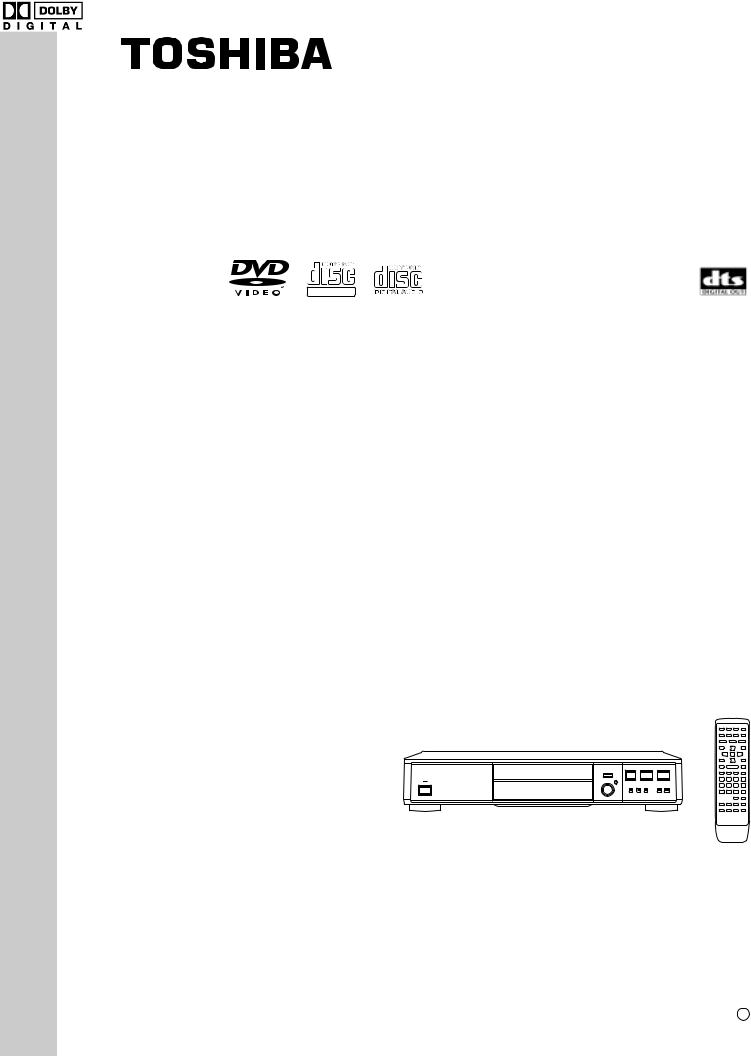
OWNER'S MANUAL
DIGITAL VIDEO
DVD VIDEO PLAYER
SD-3750
SD-K700
Jan., 2002 S

Introduction
SAFETY PRECAUTIONS
WARNING
RISK OF ELECTRIC SHOCK
DO NOT OPEN
AVIS |
RISQUE DE CHOC ELECTRIQUE NE |
PAS OUVRIR |
WARNING : TO REDUCE THE RISK OF ELECTRIC SHOCK, DO NOT REMOVE COVER (OR BACK). NO USERSERVICEABLE PARTS INSIDE. REFER SERVICING TO QUALIFIED SERVICE PERSONNEL.
The lightning flash with arrowhead symbol, within an equilateral triangle, is intended to alert the user to the presence of uninsulated “dangerous voltage” within the product’s enclosure that may be of sufficient magnitude to constitute a risk of electric shock to persons.
The exclamation point within an equilateral triangle is intended to alert the user to the presence of important operating and maintenance (servicing) instructions in the literature accompanying the appliance.
|
|
|
|
|
|
|
|
The symbol for CLASS II (Double Insulation) |
|
|
|
|
|
|
|
|
|
|
|
|
|
|
|
|
|
|
|
|
|
|
|
|
|
|
|
|
|
|
|
|
|
|
|
|
|
|
|
|
|
|
|
|
|
WARNING: |
TO REDUCE THE RISK OF FIRE OR ELECTRIC SHOCK, DO NOT EXPOSE THIS APPLIANCE |
|||||||
|
TO RAIN OR MOISTURE. DANGEROUS HIGH VOLTAGES ARE PRESENT INSIDE THE |
|||||||
|
ENCLOSURE. DO NOT OPEN THE CABINET. REFER SERVICING TO QUALIFIED PERSONNEL |
|||||||
|
ONLY. |
|||||||
CAUTION: |
TO PREVENT ELECTRIC SHOCK, MATCH WIDE BLADE OF PLUG TO WIDE SLOT, FULLY |
|||||||
|
INSERT. |
|||||||
ATTENTION: |
POUR EVITER LES CHOCS ELECTRIQUES, INTRODUIRE LA LAME LA PLUS LARGE DE LA |
|||||||
|
FICHE DANS LA BORNE CORRESPONDANTE DE LA PRISE ET POUSSER JUSQU’AU FOND. |
|||||||
CAUTION: |
This Digital Video Disc Player employs a Laser System. |
|||||||
|
To ensure proper use of this product, please read this owner’s manual carefully and retain for |
|||||||
|
future reference. Should the unit require maintenance, contact an authorized service location - |
|||||||
|
see service procedure. |
|||||||
|
Use of controls or adjustments or performance of procedures other than those specified herein |
|||||||
|
may result in hazardous radiation exposure. |
|||||||
|
To prevent direct exposure to laser beam, do not try to open the enclosure. |
|||||||
|
Visible and invisible laser radiation when open and interlocks defeated. |
|||||||
|
DO NOT STARE INTO BEAM. |
|||||||
FCC NOTICE: This equipment has been tested and found to comply with the limits for a Class B digital device, pursuant to part 15 of the FCC Rule. These limits are designed to provide reasonable protection against harmful interference in a residential installation.
This equipment generates, uses, and can radiate radio frequency energy and, if not installed and used in accordance with the instructions, may cause harmful interference to radio communications.
However, there is no guarantee that interference will not occur in a particular installation.
If this equipment does cause harmful interference to radio or television reception, which can be determined by turning the equipment off and on, the user is encouraged to try to correct the interference by one or more of the following measures:
-Reorient or relocate the receiving antenna.
-Increase the separation between the equipment and receiver.
-Connect the equipment into an outlet on a circuit different from that to which the receiver is connected.
-Consult the dealer or an experienced radio/TV technician for help.
WARNING: Changes or modifications made to this equipment, not expressly approved by Toshiba, or parties authorized by Toshiba, could void the user’s authority to operate the equipment.
2
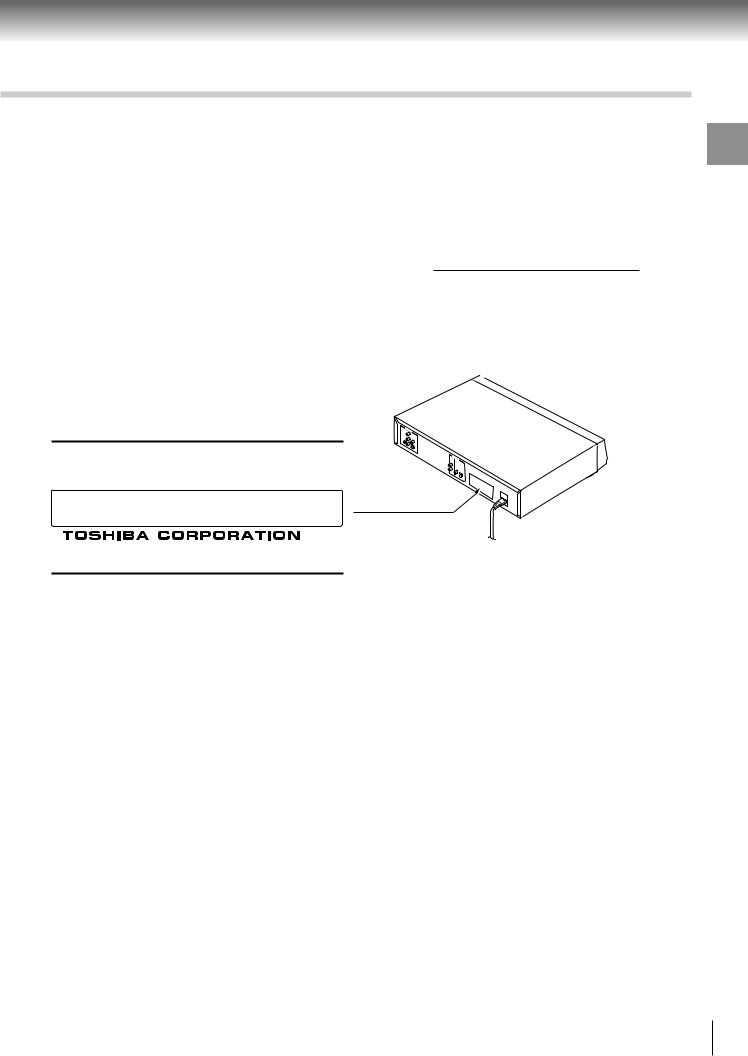
The instructions shall state that an ALL-POLE MAINS SWITCH with a contact separation of at least 3 mm in each pole shall be incorporated in the electrical installation of the building.
CAUTION: These servicing instructions are for use by qualified service personnel only. To reduce the risk of electric shock do not perform any servicing other than that contained in the operating instructions unless you are qualified to do so.
In the spaces provided below, record the Model and Serial No. located on the rear panel of your DVD player.
Model No. |
|
Serial No. |
Retain this information for future reference.
Location of the required label
Introduction
PRODUCT IS CERTIFIED BY THE MANUFACTURER TO COMPLY WITH DHHS RULE 21 CFR SUBCHAPTER J APPLICABLE AT THE DATE OF MANUFACTURE.
MANUFACTURED
1-1,SHIBAURA 1-CHOME,MINATO-KU. TOKYO 105-8001,JAPAN
3
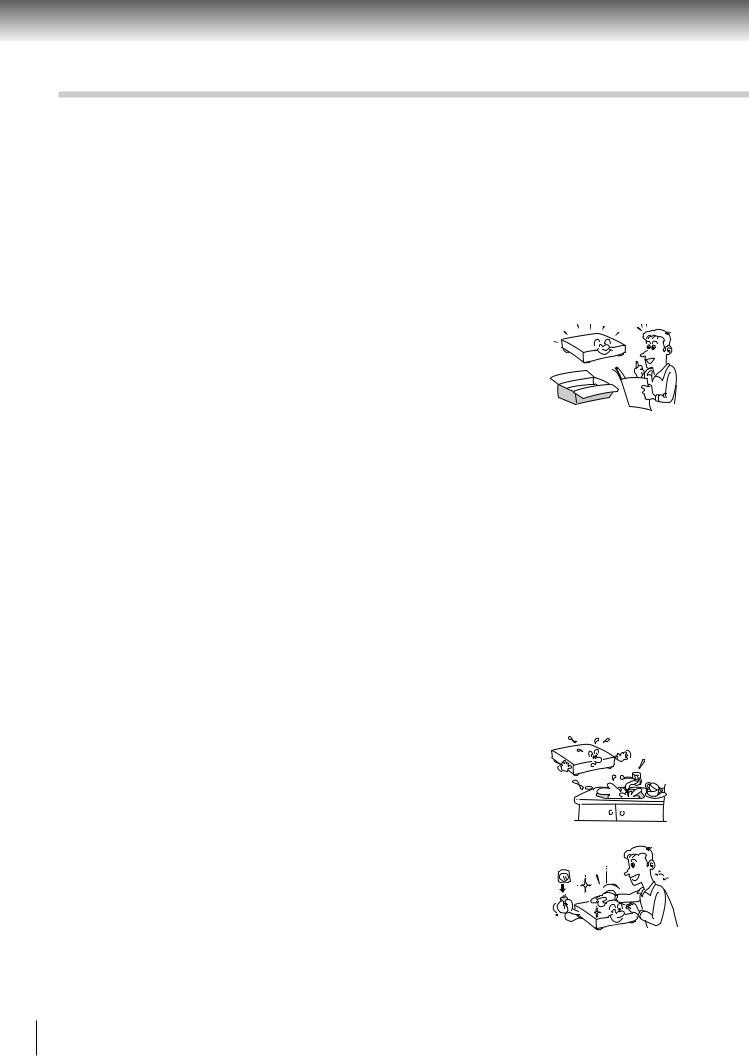
Introduction
IMPORTANT SAFETY INSTRUCTIONS
CAUTION: PLEASE READ AND OBSERVE ALL WARNINGS AND INSTRUCTIONS GIVEN IN THIS OWNER’S MANUAL AND THOSE MARKED ON THE UNIT. RETAIN THIS BOOKLET FOR FUTURE REFERENCE.
This set has been designed and manufactured to assure personal safety. Improper use can result in electric shock or fire hazard. The safeguards incorporated in this unit will protect you if you observe the following procedures for installation, use and servicing. This unit is fully transistorized and does not contain any parts that can be repaired by the user.
DO NOT REMOVE THE CABINET COVER, OR YOU MAY BE EXPOSED TO DANGEROUS VOLTAGE. REFER SERVICING TO QUALIFIED SERVICE PERSONNEL ONLY.
1. Read these instructions.
2.Keep these instructions.
3.Heed all warnings.
4.Follow all instructions.
5.Do not use this apparatus near water.
6. Clean only with dry cloth.
4

7. Do not block any ventilation openings. Install in accordance with the manufacturer’s instructions.
8. Do not install near any heat sources such as radiators, heat registers, stoves, or other apparatus (including amplifiers) that produce heat.
9.Do not defeat the safety purpose of the polarized or grounding-type plug. A polarized plug has two blades with one wider than the other. A grounding type plug has two blades and a third grounding prong. The wide blade or the
third prong are provided for your safety. If the provided plug does not fit into your outlet, consult an electrician for replacement of the obsolete outlet.
10. Protect the power cord from being walked on or pinched particularly at plugs, convenience receptacles, and the point where they exit from the apparatus.
11. Only use attachments/accessories specified by the manufacturer.
12.Use only with the cart, stand, tripod, bracket, or table specified by the manufacturer, or sold with the apparatus. When a cart is used, use caution when moving the cart/apparatus combination to avoid injury from tip-over.
S3125A
Introduction
5
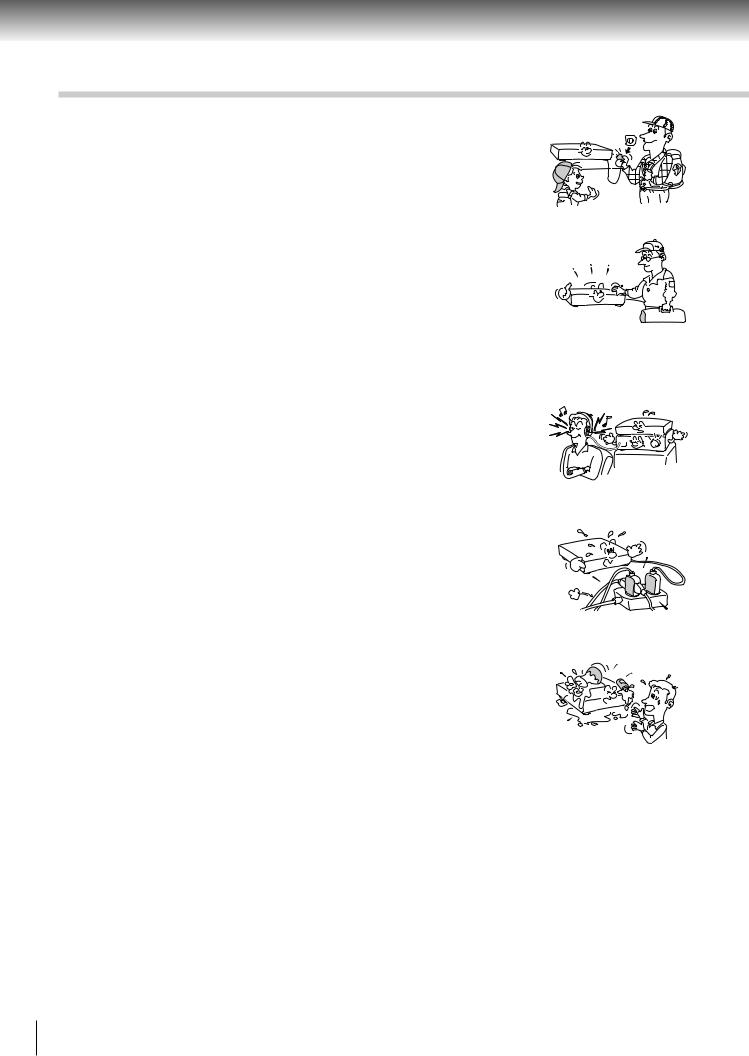
Introduction
IMPORTANT SAFETY INSTRUCTIONS
13. Unplug this apparatus during lightning storms or when unused for long periods of time.
14. Refer all servicing to qualified service personnel. Servicing is required when the apparatus has been damaged in any way, such as power-supply cord or plug is damaged, liquid has been spilled or objects have fallen into the apparatus, the apparatus has been exposed to rain or moisture, does not operate normally, or has been dropped.
15. When you use headphones, keep the volume at a moderate level. If you use the headphones continuously with high volume sound, it may cause hearing damage.
16. Do not overload wall outlets; extension cords, or integral convenience receptacles as this can result in a risk of fire or electric shock.
17. Never insert objects of any kind into this apparatus through openings as they may touch dangerous voltage points or short-out parts that could result in a fire or electric shock. Never spill liquid of any kind on the apparatus.
6
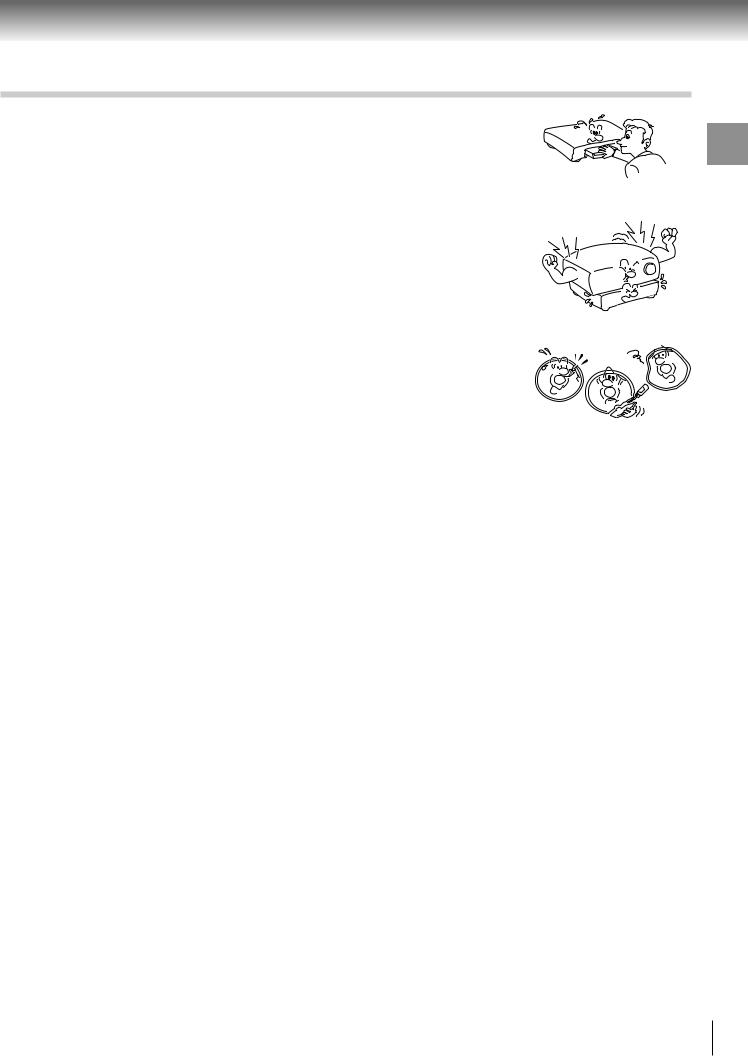
18.Keep your fingers well clear of the disc tray as it is closing. Neglecting to do so may cause serious personal injury.
19.Do not place a heavy object on or step on the apparatus. The object may fall, causing serious personal injury and serious damage to the apparatus.
20.Do not use a cracked, deformed, or repaired disc. These discs are easily broken and may cause serious personal injury and apparatus malfunction.
Introduction
7

Introduction
 Precautions
Precautions
Notes on handling |
Notes on moisture condensation |
When shipping the DVD player, the original shipping carton and packing materials come in handy. For maximum protection, repack the unit as it was originally packed at the factory.
Do not use volatile liquids, such as insect spray, near the DVD player. Do not leave rubber or plastic products in contact with the DVD player for a long time. They will leave marks on the finish.
The top and rear panels of the DVD player may become warm after a long period of use. This is not a malfunction.
When the DVD player is not in use, be sure to remove the disc and turn off the power.
If you do not use the DVD player for a long period, the unit may not function properly in the future. Turn on and use the DVD player occasionally.
Notes on locating
Place the DVD player on a level surface. Do not use it on a shaky or unstable surface such as a wobbling table or inclined stand. The loaded disc may come off the proper position and cause damage to the DVD player.
When you place this DVD player near a TV, radio, or VCR, the playback picture may become poor and the sound may be distorted. In this case, place the DVD player away from the TV, radio, or VCR.
Notes on cleaning
Use a soft, dry cloth for cleaning.
 For stubborn dirt, soak the cloth in a weak detergent solution, wring well and wipe. Use a dry cloth to wipe it dry.
For stubborn dirt, soak the cloth in a weak detergent solution, wring well and wipe. Use a dry cloth to wipe it dry.
Do not use any type of solvent, such as thinner and benzine, as they may damage the surface of the DVD player.
 If you use a chemical saturated cloth to clean the unit, follow that product’s instructions.
If you use a chemical saturated cloth to clean the unit, follow that product’s instructions.
To obtain a clear picture
The DVD player is a high technology, precision device. If the optical pick-up lens and disc drive parts are dirty or worn down, the picture quality becomes poor. To obtain a clear picture, we recommend regular inspection and maintenance (cleaning or parts replacement) every 1,000 hours of use depending on the operating environment. For details, contact your nearest dealer.
Moisture condensation damages the DVD player. Please read the following carefully.
Moisture condensation occurs, for example, when you pour a cold drink into a glass on a warm day. Drops of water form on the outside of the glass. In the same way, moisture may condense on the optical pick-up lens inside this unit, one of the most crucial internal parts of the DVD player.
|
|
le of m |
|
|
|
|
mp |
ois |
tu |
||
a |
|
|
|
||
Ex |
|
|
e |
|
re |
|
|
ond nsatio |
n! |
||
|
c |
|
|||


 Optical pick-up lens
Optical pick-up lens
Moisture condensation occurs during the following cases.
 When you bring the DVD player directly from a cold place to a warm place.
When you bring the DVD player directly from a cold place to a warm place.
 When you use the DVD player in a room where you just turned on the heater, or a place where the cold wind from the air conditioner directly hits the unit.
When you use the DVD player in a room where you just turned on the heater, or a place where the cold wind from the air conditioner directly hits the unit.
 In summer, when you use the DVD player in a hot and humid place just after you move the unit from an air conditioned room.
In summer, when you use the DVD player in a hot and humid place just after you move the unit from an air conditioned room.
 When you use the DVD player in a humid place.
When you use the DVD player in a humid place.
It’s too warm!
Do not use the DVD player when moisture condensation may occur.
If you use the DVD player in such a situation, it may damage discs and internal parts. Remove the disc, connect the power cord of the DVD player to the wall outlet, turn on the DVD player, and leave it for two or three hours. After two or three hours, the DVD player will have warmed up and evaporated any moisture. Keep the DVD player connected to the wall outlet and moisture condensation will seldom occur.
Wait! |
Wall outlet |
|
8
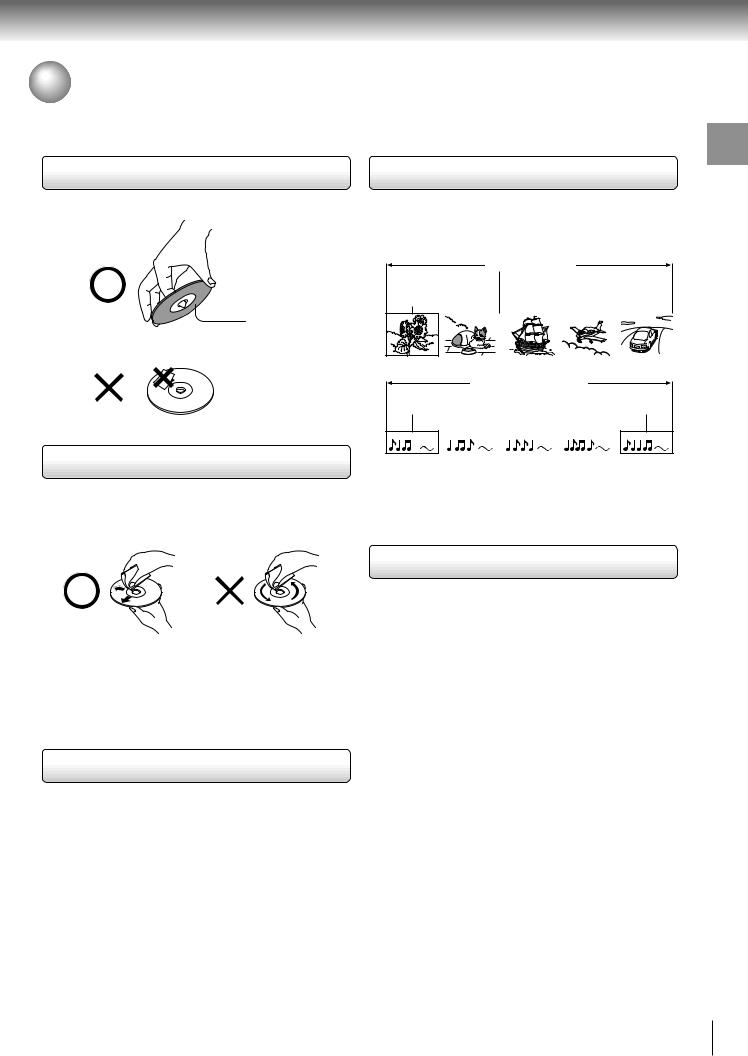
 Notes on Discs
Notes on Discs
On handling discs
 Do not touch the playback side of the disc.
Do not touch the playback side of the disc.
Playback side
 Do not attach paper or tape to discs.
Do not attach paper or tape to discs.
Structure of disc contents
Normally, DVD video discs are divided into titles, and the titles are sub-divided into chapters. VIDEO CDs/ audio CDs are divided into tracks.
DVD video disc
 Title 1
Title 1 
 Title 2
Title 2 
Chapter 1 Chapter 2 |
Chapter 1 Chapter 2 Chapter 3 |
|||||||||||||||
|
|
|
|
|
|
|
|
|
|
|
|
|
|
|
|
|
|
|
|
|
|
|
|
|
|
|
|
|
|
|
|
|
|
|
|
|
|
|
|
|
|
|
|
|
|
|
|
|
|
|
|
|
|
|
|
|
|
|
|
|
|
|
|
|
|
|
|
|
|
|
|
|
|
|
|
|
|
|
|
|
|
|
|
|
VIDEO CD/Audio CD
Track 1 |
Track 2 |
Track 3 |
Track 4 |
Track 5 |
|||||
|
|
|
|
|
|
|
|
|
|
|
|
|
|
|
|
|
|
|
|
On cleaning discs
 Fingerprints and dust on the disc cause picture and sound deterioration. Wipe the disc from the center outwards with a soft cloth. Always keep the disc clean.
Fingerprints and dust on the disc cause picture and sound deterioration. Wipe the disc from the center outwards with a soft cloth. Always keep the disc clean.
 If you cannot wipe off the dust with a soft cloth, wipe the disc lightly with a slightly moistened soft cloth and finish with a dry cloth.
If you cannot wipe off the dust with a soft cloth, wipe the disc lightly with a slightly moistened soft cloth and finish with a dry cloth.
 Do not use any type of solvent such as thinner, benzine, commercially available cleaners or antistatic spray for vinyl LPs. It may damage the disc.
Do not use any type of solvent such as thinner, benzine, commercially available cleaners or antistatic spray for vinyl LPs. It may damage the disc.
On storing discs
 Do not store discs in a place subject to direct sunlight or near heat sources.
Do not store discs in a place subject to direct sunlight or near heat sources.
 Do not store discs in places subject to moisture and dust such as a bathroom or near a humidifier.
Do not store discs in places subject to moisture and dust such as a bathroom or near a humidifier.  Store discs vertically in a case. Stacking or placing objects on discs outside of their case may cause warping.
Store discs vertically in a case. Stacking or placing objects on discs outside of their case may cause warping.
Each title, chapter or track is assigned a number, which is called “title number”, “chapter number” or “track number” respectively.
There may be discs that do not have these numbers.
Notes on copyright
It is forbidden by law to copy, broadcast, show, broadcast on cable, play in public, and rent copyrighted material without permission.
DVD video discs are copy protected, and any recordings made from these discs will be distorted.
This product incorporates copyright protection technology that is protected by method claims of certain U.S. patents and other intellectual property rights owned by Macrovision Corporation and other rights owners. Use of this copyright protection technology must be authorized by Macrovision Corporation, and is intended for home and other limited viewing uses only unless otherwise authorized by Macrovision Corporation. Reverse engineering or disassembly is prohibited.
Introduction
9
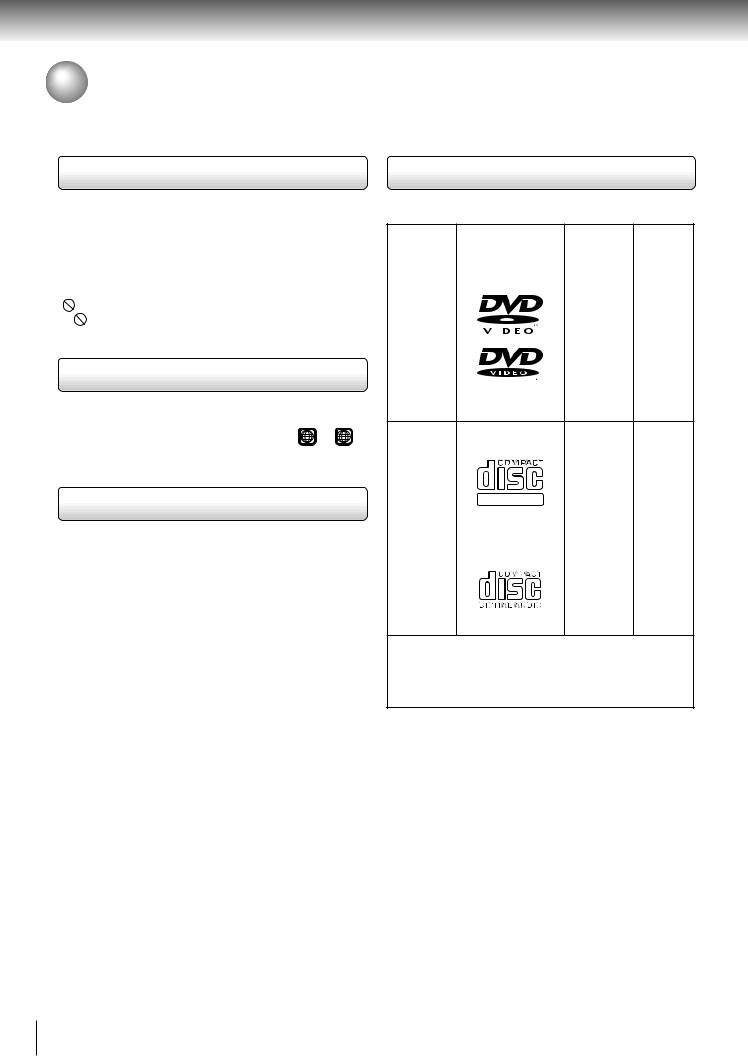
Introduction
 Notes on Discs (continued)
Notes on Discs (continued)
About this owner’s manual |
Playable discs |
This owner’s manual explains the basic instructions of this DVD player. Some DVD video discs are produced in a manner that allows specific or limited operation during playback. As such, the DVD player may not respond to all operating commands. This is not a defect in the DVD player. Refer to instruction notes of discs.
“ ” may appear on the TV screen during operation. A “ ” means that the operation is not permitted by the DVD player or the disc.
Notes on region numbers
The region number of this DVD player is 1. If region numbers, which stand for their playable area, are printed on your DVD video disc and you do not find 1 or ALL , disc playback will not be allowed by the player. (In this case, the DVD player will display a message on-screen.)
On VIDEO CDs
This DVD player supports VIDEO CDs equipped with the PBC (Version 2.0) function. (PBC is the abbreviation of Playback Control.) You can enjoy two playback variations depending on types of discs.
•VIDEO CD not equipped with PBC function (Version 1.1)
Sound and movie can be played on this DVD player in the same way as an audio CD.
•VIDEO CD equipped with PBC function (Version 2.0)
In addition to operation of a VIDEO CD not equipped with the PBC function, you can enjoy playback of interactive software with search function by using the menu displayed on the TV screen (Menu Playback). Some of the functions described in this owner’s manual may not work with some discs.
This DVD player can play the following discs.
Disc Mark |
Contents |
Disc |
|||
Size |
|||||
|
|
|
|
||
|
|
|
|
12 cm |
|
DVD |
|
|
video |
|
|
|
|
(moving |
|
||
video |
|
|
pictures) |
|
|
|
|||||
discs |
+ |
|
|||
|
|
|
Audio |
|
|
|
|
|
|
8 cm |
|
|
|
12 cm |
|
VIDEO |
video |
|
|
(moving |
|
||
CDs |
pictures) |
|
|
DIGITAL VIDEO |
+ |
|
|
|
Audio |
8 cm |
|
|
|
|
|
|
|
12 cm |
|
Audio |
Audio |
|
|
CDs |
8 cm |
||
|
|||
|
|
||
|
|
(CD single) |
The following discs are also available.
 DVD-R discs of DVD video format
DVD-R discs of DVD video format
 CD-R/CD-RW discs of CD-DA format
CD-R/CD-RW discs of CD-DA format
Some of these discs may be incompatible.
•You cannot play discs other than those listed above.
•You cannot play discs of DVD-RAM or non-standardized discs, etc., even if they may be labeled as above.
•This DVD player uses the NTSC color system, and cannot play DVD video discs recorded in any other color system (PAL, SECAM, etc.).
10

 Table of Contents
Table of Contents
Introduction |
|
SAFETY PRECAUTIONS .......................... |
2 |
IMPORTANT SAFETY INSTRUCTIONS ... |
4 |
Precautions ............................................... |
8 |
Notes on Discs .......................................... |
9 |
Notes on region numbers ............................... |
10 |
Table of Contents ................................... |
11 |
Identification of Controls ....................... |
12 |
Front panel ..................................................... |
12 |
Rear panel ...................................................... |
12 |
DVD display .................................................... |
13 |
Remote control ............................................... |
14 |
Loading batteries ............................................ |
15 |
Operating with the remote control .................. |
15 |
Connections |
|
Connecting to a TV ................................. |
18 |
Connecting to a TV ......................................... |
18 |
Connecting to an audio system and TV |
|
equipped with component video inputs ........ |
19 |
Connecting to Optional Equipment ...... |
20 |
Connecting to an amplifier equipped with a |
|
Dolby Digital decoder ................................... |
21 |
Connecting to an amplifier equipped with |
|
Dolby Pro Logic Surround ............................ |
21 |
Connecting to an amplifier equipped with a |
|
DTS decoder ................................................ |
22 |
Connecting to an amplifier equipped with an |
|
MPEG2 audio decoder ................................. |
22 |
Connecting to an amplifier equipped with a |
|
digital audio input ......................................... |
23 |
Basic playback |
|
Playing a Disc ......................................... |
26 |
Basic playback ............................................... |
26 |
Variable Speed Playback ....................... |
28 |
Playing in fast reverse or |
|
fast forward directions .................................. |
28 |
Playing frame by frame .................................. |
28 |
Playing in slow-motion .................................... |
29 |
Resuming playback from the same location ... |
29 |
Locating a Desired Section ................... |
30 |
Locating a title using the top menu ................. |
30 |
Locating a desired section by entering the |
|
corresponding number ................................. |
31 |
Locating a specific chapter or track ................ |
31 |
Advanced playback |
|
Accessing a Specific Location Directly .. 34 |
|
Entering the time counter of the desired |
|
location ......................................................... |
34 |
Playing Repeatedly ................................. |
35 |
Repeating a title, chapter, or track .................. |
35 |
Repeating a specific segment ........................ |
35 |
Playing in a Favorite Order .................... |
36 |
Setting titles, chapters, or tracks in a favorite |
|
order ............................................................. |
36 |
Playing in Random Order ...................... |
37 |
Playing titles, chapters, or tracks in random |
|
order ............................................................. |
37 |
Zooming a Picture .................................. |
38 |
Zooming a picture ........................................... |
38 |
Selecting the Sound Enhancement |
|
(E.A.M.) .................................................... |
39 |
Selecting the sound enhancement ................. |
39 |
Selecting the Camera Angle .................. |
40 |
Changing the camera angle ........................... |
40 |
Selecting Subtitles ................................. |
41 |
Selecting a subtitle language ......................... |
41 |
Selecting a Language ............................. |
42 |
Selecting a playback audio setting ................. |
42 |
Quick control |
|
Using the Graphic Remote Control |
|
- V-REMOTE - .......................................... |
46 |
Selecting the Playback Function |
|
- QUICK - .................................................. |
47 |
Accessing Features |
|
- NAVI - ..................................................... |
48 |
Function setup |
|
Customizing the Function Settings ...... |
56 |
Setting procedure ........................................... |
56 |
Setting details ................................................. |
58 |
Table of Languages ................................ |
65 |
Others |
|
Before Calling Service Personnel ......... |
68 |
Specifications ......................................... |
69 |
LIMITED WARRANTY DVD PLAYER ...... |
70 |
Introduction
11

Introduction
 Identification of Controls
Identification of Controls
See the page in  for details.
for details.
Front panel |
|
|
|
|
|
|
|
POWER indicator 26 |
OPEN/CLOSE button 26 |
PAUSE button 27 |
|||||
|
|
|
|
Disc tray 26 |
|
STOP button 27 |
|
|
|
|
|
|
|
PLAY button 26 |
|
|
|
|
|
|
|
|
|
|
|
|
|
|
PAUSE |
STOP |
PLAY |
|
|
|
|
|
OPEN/CLOSE |
|
|
POWER |
|
|
|
|
NAVI |
|
|
|
|
|
|
|
TOP MENU MENU RETURN |
SKIP |
|
|
|
|
|
|
|
||
|
|
|
|
|
ENTER |
|
|
|
|
|
DVD display 13 |
|
|
SKIP buttons 31 |
|
POWER button 26 |
|
|
|
|
|
RETURN button 56 |
|
|
/ |
/ |
/ |
/ ENTER button |
56 |
MENU button |
|
|
|
|
|
|
|
||
|
|
|
NAVI button 48 |
TOP MENU button 30 |
|||
Rear panel
ColorStream® (Component video) |
2CH AUDIO OUT jacks 18 |
19 |
VIDEO OUT jacks (Y/PB/PR) 19 |
|
|
VIDEO OUT jack 18 |
BITSTREAM/PCM COAXIAL (DIGITAL) |
|
AUDIO OUT jack 21 |
22 23 |
|
AC inlet
|
VIDEO OUT |
|
AUDIO OUT |
|
|
|
|
Y |
2CH |
BITSTREAM |
AC IN |
|
|
|
/PCM |
||
|
|
|
|
||
|
|
|
VIDEO |
|
|
|
|
PB |
|
L |
|
SELECT |
PR |
S |
R |
|
|
|
|
|
|||
I |
P |
|
|
COAXIAL OPTICAL |
|
|
|
|
|
DIGITAL |
|
S VIDEO OUT jack 18 |
BITSTREAM/PCM OPTICAL (DIGITAL) |
SELECT (I/P) switch |
AUDIO OUT jack 21 22 23 |
|
19 |
|
When connecting the optical digital cable, remove |
Power cord |
the cap and fit the connector into the jack firmly. |
|
When not using the jack, keep the cap inserted |
|
to protect it from dust intrusion. |
|
12

DVD display
Chapter/track number indicator
Title number indicator
Play mode indicator
Repeated pressing of the FL DIMMER button on the remote control changes the brightness of the display.
FL DIMMER |
Normal |
|
Dimmed |
|
Off |
||
|
|
||||||
|
|
|
|
|
|
|
|
|
|
|
|
|
|
|
|
Remaining time/elapsed time indicators
Memory playback indicator
Random playback indicator
HDCD |
TITLE |
CHP |
TRK |
REMAIN |
MEMORY |
RANDOM |
A-B |
|
|
|
|
|
|
|
|
DVD |
|
|
|
|
|
|
|
V C D |
|
|
|
|
|
|
|
VIDEO CD/CD indicator |
Multifunctional indicator (indicates operating |
|
DVD indicator |
status or messages, etc.) |
Angle icon indicator |
|
|
|
Repeat playback indicator
The indicators vary depending on the kinds of discs you play.
DVD video disc
• During playback:
Example
HDCD |
TITLE GROUP CHP TRK |
TOTAL REMAIN MEMORY RANDOM A-B |
|
|||||
DVD-AUDIO |
|
|
|
|
||||
S V C D V D |
|
|
|
|
|
|
|
|
|
|
|
|
|
|
|
||
|
|
|
|
|
||||
Playing chapter 3 |
Elapsed time of |
|||||||
of title 2 |
the current title |
|||||||
•Some discs may not display chapter numbers.
•A time indication not accompanied with a chapter number shows elapsed time of a segment within the current title.
|
|
VIDEO CD |
|
|
|
Audio CD |
||||||||||||||
• During playback: |
• During playback: |
|||||||||||||||||||
Example |
|
Example |
||||||||||||||||||
|
HDCD |
TITLE GROUP CHP TRK TOTAL REMAIN MEMORY RANDOM A-B |
|
|
|
HDCD |
TITLE GROUP CHP TRK TOTAL REMAIN MEMORY RANDOM A-B |
|
||||||||||||
|
DVD-AUDIO |
|
|
|
DVD-AUDIO |
|
||||||||||||||
|
S V C D V D |
|
|
|
|
|
|
|
|
|
S V C D V D |
|
|
|
|
|
|
|
||
|
|
|
|
|
|
|
|
|
|
|
|
|
|
|
|
|
|
|
|
|
|
Playing track 6 Elapsed time of |
|
|
Playing track 6 Elapsed time of |
||||||||||||||||
|
|
|
|
|
the current track |
|
|
|
|
|
|
the current track |
||||||||
Some discs may not display track numbers or elapsed time.
Introduction
13

Introduction
 Identification of Controls (continued)
Identification of Controls (continued)
The instructions in this manual describe the functions on the remote control. See the page in  for details.
for details.
Remote control
OPEN/CLOSE button 26
FL DIMMER button 13
ZOOM buttons 38
QUICK button 47
TOP MENU button 30
ENTER button 56
Direction buttons 56 ( /
/ /
/ /
/ )
)
CLEAR button 31
PAUSE/STEP button 27
SKIP buttons 31
|
|
|
|
Power button |
26 |
OPEN/CLOSE FL DIMMER |
SETUP |
|
SETUP button 56 |
||
|
|
|
|
||
ZOOM |
|
E.A.M |
E.A.M button |
39 |
|
|
|
|
|
||
QUICK |
V-REMOTE |
NAVI |
|
|
|
|
|
|
|
NAVI button |
48 |
TOP MENU |
|
|
MENU |
MENU button* |
|
|
|
|
|
||
|
ENTER |
|
|
|
|
|
|
|
|
V-REMOTE button 46 |
|
CLEAR |
|
|
RETURN |
|
|
|
|
|
|
RETURN button 56 |
|
PAUSE/STEP |
PLAY |
STOP |
|
|
|
|
|
|
|
STOP button |
27 |
SKIP |
|
REV |
FWD |
|
|
|
|
|
|
PLAY button |
26 |
|
|
|
SEARCH |
|
|
1 |
2 |
3 |
T |
FWD button |
28 |
4 |
5 |
6 |
+10 |
REV button 28 |
|
7 |
8 |
9 |
0 |
T button 31 |
|
SLOW
Number buttons 31
ANGLE button 40
RANDOM button 37
SUBTITLE button 41
MEMORY button 36
|
|
SLOW buttons 29 |
|
ANGLE SUBTITLE AUDIO |
COLORSTREAM |
|
|
SELECTOR |
COLORSTREAM SELECTOR |
||
|
|
||
RANDOM MEMORY REPEAT A-B RPT |
button 19 |
|
|
|
|
A-B RPT button |
35 |
|
|
AUDIO button 42 |
|
|
|
REPEAT button |
35 |
*MENU button
Use the MENU button to display the menu included on many DVD video discs. To operate a menu, follow the instructions in “Locating a title using the top menu.” 30
14

Loading batteries
1 Open the cover.
2 Insert batteries (AA size).
Make sure to match the + and – on the batteries to the marks inside the battery compartment.
3 Close the cover.
Notes on batteries
Improper use of batteries may cause battery leakage and corrosion. To operate the remote control correctly, follow the instructions below.
•Do not insert batteries into the remote control in the wrong direction.
•Do not charge, heat, open, or short-circuit the batteries. Do not throw batteries into a fire.
•Do not leave dead or exhausted batteries in the remote control.
•Do not use different types of batteries together, or mix old and new batteries.
•If you do not use the remote control for a long period of time, remove the batteries to avoid possible damage from battery corrosion.
•If the remote control does not function correctly or if the operating range becomes reduced, replace all batteries with new ones.
•If battery leakage occurs, wipe the battery liquid from the battery compartment, then insert new batteries.
Operating with the remote control
Point the remote control at the remote sensor and press the buttons.
30° 30°
Within about 7 m (23 feet)
Distance: About 7 m (23 feet) from the front of the remote sensor
Angle: About 30° in each direction of the front of the remote sensor
*Do not expose the remote sensor of the DVD player to a strong light source such as direct sunlight or other illumination. If you do so, you may not be able to operate the DVD player via the remote control.
Notes on the remote control
•Direct the remote control at the remote sensor of the DVD player.
•Do not drop or give the remote control a shock.
•Do not leave the remote control near an extremely hot or humid place.
•Do not spill water or put anything wet on the remote control.
•Do not open the remote control.
Introduction
15

Connections
Read this chapter first to make all necessary preparations.
 Connecting to a TV
Connecting to a TV
Connecting to an audio system and TV equipped with component video inputs
 Connecting to an amplifier equipped with a Dolby Digital decoder
Connecting to an amplifier equipped with a Dolby Digital decoder
 Connecting to an amplifier equipped with Dolby Pro Logic Surround
Connecting to an amplifier equipped with Dolby Pro Logic Surround
 Connecting to an amplifier equipped with a DTS decoder
Connecting to an amplifier equipped with a DTS decoder
 Connecting to an amplifier equipped with an MPEG2 audio decoder
Connecting to an amplifier equipped with an MPEG2 audio decoder
 Connecting to an amplifier equipped with a digital audio input
Connecting to an amplifier equipped with a digital audio input
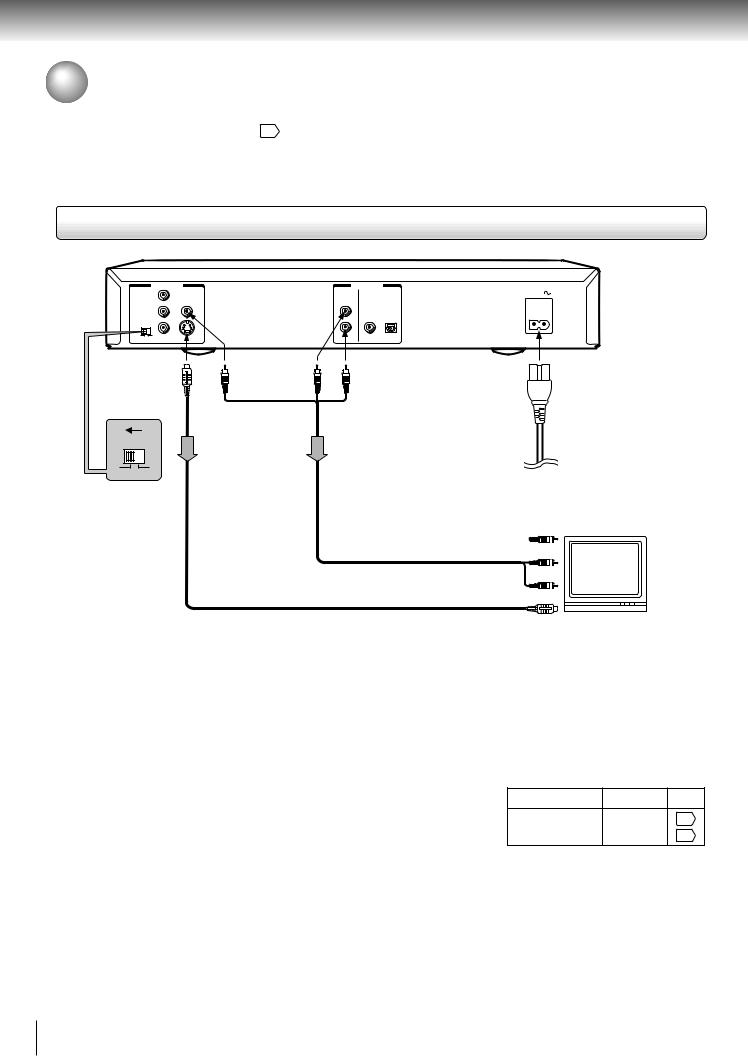
Connections
 Connecting to a TV
Connecting to a TV
Connect the DVD player to your TV.
For details of output sound, see 43 .
Connecting to a TV
|
VIDEO OUT |
|
AUDIO OUT |
|
|
|
|
Y |
2CH |
BITSTREAM |
AC IN |
|
|
|
/PCM |
||
|
|
|
|
||
|
|
|
VIDEO |
|
|
|
|
PB |
|
L |
|
SELECT |
PR |
S |
R |
|
|
|
|
|
|||
I |
P |
|
|
COAXIAL OPTICAL |
|
|
|
|
|
DIGITAL |
|
 Signal flow
Signal flow
To S VIDEO OUT |
(yellow) (white) |
(red) |
|
|
|
To VIDEO OUT |
To 2CH AUDIO OUT |
SELECT |
|
|
|
I |
P |
|
|
Set to “I.”
S video cable |
Audio/video cable |
(not supplied) |
(supplied) |
If the TV has an S video input, connect the DVD player with an S video cable. When using an S video cable, do not connect the yellow video cable.
To wall outlet
TV or monitor with (red) audio/video inputs
To audio inputs (white)
(white)
To video input (yellow)
To S video input
• Make the following setting.
On-screen display |
Select: |
Page |
“Bitstream” 56 “Audio Out Select” or
“PCM” 59
Notes
•Refer to the owner’s manual of the connected TV as well.
•When you connect the DVD player to your TV, be sure to turn off the power and unplug both units from the wall outlet before making any connections.
•If your television set has one audio input, connect the left and right audio outputs of the DVD player to a Y cable adapter (not supplied) and then connect to your TV.
•Connect the DVD player directly to your TV. If you connect the DVD player to a VCR, TV/VCR combination or video selector, the playback picture may be distorted as DVD video discs are copy protected.
18
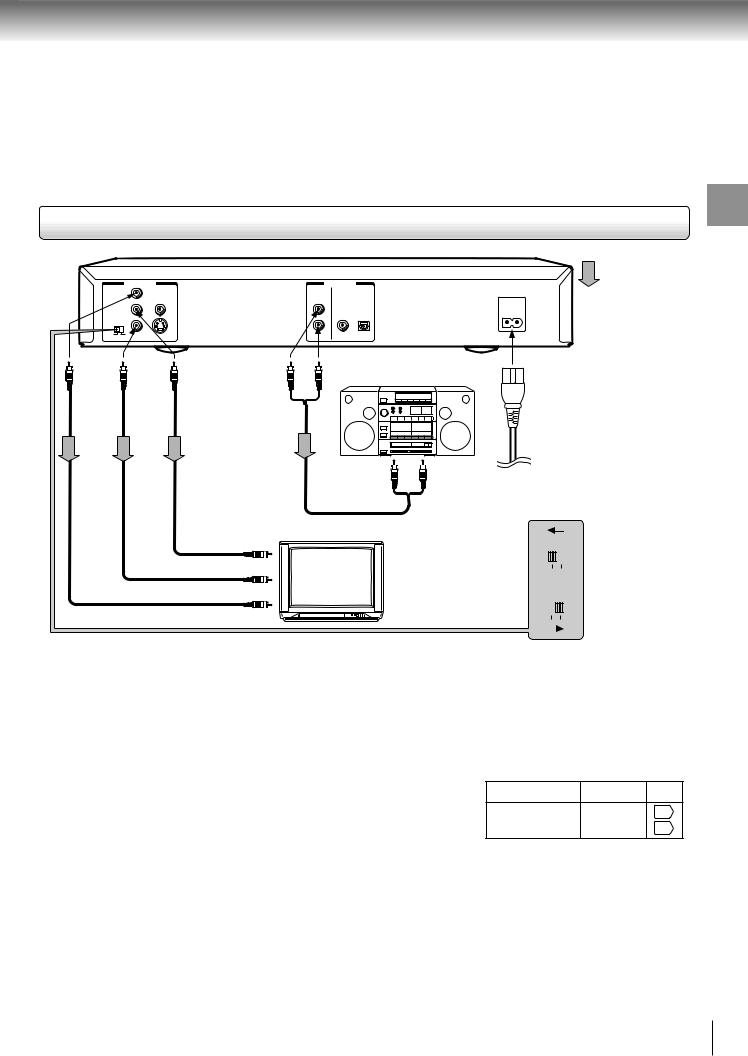
INTERLACED outputs/inputs (ColorStream® )
Some TVs or monitors are equipped with component video inputs. Connecting to these inputs allows you to enjoy higher quality picture playback.
Actual labels for component video inputs may vary depending on the TV manufacturer. (ex. Y, R-Y, B-Y or Y, CB, CR)
In some TVs or monitors, the color levels of the playback picture may be reduced slightly or the tint may change. In such a case, adjust the TV or monitor for optimum performance.
PROGRESSIVE outputs/inputs (ColorStream® Pro)
Some TVs or monitors are equipped with component video inputs that are capable of reproducing a progressively scanned video signal. Connecting to these inputs allows you to view the highest quality pictures with less flicker.
Connecting to an audio system and TV equipped with component video inputs
|
VIDEO OUT |
|
AUDIO OUT |
|
|
|
Y |
2CH |
BITSTREAM |
|
|
|
/PCM |
|
|
|
|
VIDEO |
|
|
|
PB |
|
L |
SELECT |
PR |
S |
R |
|
|
|
|||
I |
P |
|
|
COAXIAL OPTICAL |
|
|
|
|
DIGITAL |
To Y |
To PR |
To PB |
(white) |
(red) |
VIDEO |
VIDEO |
VIDEO |
|
Audio system |
|
|
|||
OUT |
OUT |
OUT |
|
|
Signal flow
AC IN 
To 2CH AUDIO OUT |
(red) |
(white) |
To wall outlet
To audio inputs of the amplifier
To PB video input
To PR video input
To Y video input
TV or monitor with |
SELECT |
|||||||||||
component video |
|
|
|
|
|
|
|
|
|
|
Set to “I.” |
|
(INTERLACED) inputs |
I |
|
|
|
|
|
|
|
|
P |
||
|
|
|
|
|
||||||||
or |
|
|
|
|
|
|
|
|
|
|
|
|
|
|
|
|
|
|
|
|
|
|
|
|
|
TV or monitor with |
SELECT |
|||||||||||
component video |
|
|
|
|
|
|
|
|
|
|
Set to “P.” |
|
(PROGRESSIVE) inputs |
I |
|
|
|
|
|
|
|
|
|
P |
|
|
|
|
|
|
|
|
|
|
||||
 Switching the output signal (interlaced/ progressive) using the remote control
Switching the output signal (interlaced/ progressive) using the remote control
(only when the SELECT (I/P) switch is set to “P”)
You can temporarily switch the output signal for better picture quality.
Press COLORSTREAM SELECTOR on the remote control.
• Make the following setting.
On-screen display |
Select: |
Page |
“Bitstream” 56 “Audio Out Select” or
“PCM” 59
Notes
•Refer to the owner’s manual of the connected equipment as well.
•When you connect the DVD player to other equipment, be sure to turn off the power and unplug all of the equipment from the wall outlet before making any connections.
•If you place the DVD player near a tuner or radio, the radio broadcast sound might be distorted. In this case, place the DVD player away from the tuner and radio.
•The output sound of the DVD player has a wide dynamic range. Be sure to adjust the receiver’s volume to a moderate listening level. Otherwise, the speakers may be damaged by a sudden high volume sound.
•Turn off the amplifier before you connect or disconnect the DVD player’s power cord. If you leave the amplifier power on, the speakers may be damaged.
•The S VIDEO OUT jack and the VIDEO OUT jack cannot output video signals, if you select progressive signal when the SELECT (I/P) switch is set to “P.”
Connections
19

Connections
 Connecting to Optional Equipment
Connecting to Optional Equipment
You can enjoy high quality dynamic sounds by connecting the DVD player to optional audio equipment.
• For connection to your TV, see “Connecting to a TV”
1819 .
•For details of output sound, see 43 .
•This section uses the following reference marks.
: Front speaker
: Rear speaker
: Sub woofer
: Center speaker
: Signal flow
Notes
•DO NOT connect the BITSTREAM/PCM (DIGITAL) AUDIO OUT jack of the DVD player to the AC-3 RF input of a Dolby Digital Receiver. This input on your A/V Receiver is reserved for Laserdisc use only and is incompatible with the BITSTREAM/PCM (DIGITAL) AUDIO OUT jack of the DVD player.
•Connect the BITSTREAM/PCM (DIGITAL) AUDIO OUT jack of the DVD player to the “DIGITAL (OPTICAL)” or “DIGITAL (COAXIAL)” input of a Receiver or Processor.
•Refer to the owner’s manual of the connected equipment as well.
•When you connect the DVD player to other equipment, be sure to turn off the power and unplug all of the equipment from the wall outlet before making any connections.
•The output sound of the DVD player has a wide dynamic range. Be sure to adjust the receiver’s volume to a moderate listening level. Otherwise, the speakers may be damaged by a sudden high volume sound.
•Turn off the amplifier before you connect or disconnect the DVD player’s power cord. If you leave the amplifier power on, the speakers may be damaged.
Warning
•When you are connecting (via the BITSTREAM/PCM (DIGITAL) AUDIO OUT jack) an AV decoder that does not have Dolby Digital, Digital Theater Systems (DTS) or MPEG2 decoding function, be sure to set “Audio Out Select” to “PCM” from the on-screen displays56 59 . Otherwise, high volume sound may damage your hearing as well as the speakers.
•When playing DTS-encoded discs (audio CDs), excessive noise may be output from the analog audio output jacks. To avoid possible damage to the audio system, you should take proper precautions when the analog audio output jacks of the DVD player are connected to an amplification system. To enjoy DTS Digital Surround™ playback, an external 5.1 channel DTS Digital Surround™ decoder system must be connected to the BITSTREAM/PCM (DIGITAL) AUDIO OUT jack of the DVD player.
20

Connecting to an amplifier equipped with a Dolby Digital decoder
Dolby Digital
Dolby Digital is the surround sound technology used in theaters showing the latest movies, and is now available to reproduce this realistic effect in the home. You can enjoy motion picture and live concert DVD video discs with this dynamic realistic sound by connecting the DVD player to a 6 channel amplifier equipped with a Dolby Digital decoder or Dolby Digital processor. If you have a Dolby Pro Logic Surround decoder, you will obtain the full benefit of Pro Logic from the same DVD movies that provide full 5.1-channel Dolby Digital soundtracks, as well as from titles with the Dolby Surround mark.
Manufactured under license from Dolby Laboratories. “Dolby”, “Pro Logic” and the double-D symbol are trademarks of Dolby Laboratories. Confidential unpublished works. ©1992-1997 Dolby Laboratories. All rights reserved.
•Use DVD video discs encoded via the Dolby Digital recording system.
•Make the following setting.
Amplifier equipped with a Dolby Digital decoder
To OPTICAL |
To COAXIAL |
type digital |
type digital |
audio input |
audio input |
|
|
|
On-screen display |
Select: |
Page |
VIDEO OUT |
AUDIO OUT |
|
|
|
|
|
2CH |
BITSTREAM |
|
56 |
|
|
Y |
/PCM |
|
||
|
PB |
L |
|
|
|
|
VIDEO |
|
|
|
|
SELECT |
PR S |
R |
“Audio Out Select” |
“Bitstream” |
59 |
I P |
|
COAXIAL |
OPTICAL |
|
|
|
|
DIGITAL |
|
|
|
|
Connect either. |
Recording system |
D |
42 |
|
|
|
|
|
||
75 Ω |
coaxial cable |
|
|
|
|
Optical digital cable |
|
|
|
|
|
Connections
Connecting to an amplifier equipped with Dolby Pro Logic Surround
Dolby Pro Logic Surround
You can enjoy the dynamic realistic sound of Dolby Pro Logic Surround by connecting an amplifier and speaker system (right and left front speakers, a center speaker, and one or two rear speakers).

 With an amplifier equipped with Dolby Digital
With an amplifier equipped with Dolby Digital
Connect the equipment the same way as described in “Connecting to an amplifier equipped with a Dolby Digital decoder.” Refer to that amplifier’s owner’s manual and set the amplifier so you can enjoy Dolby Pro Logic Surround sound.

 With an amplifier not equipped with Dolby Digital
With an amplifier not equipped with Dolby Digital
Connect the equipment as follows.
|
Amplifier equipped with |
VIDEO OUT |
AUDIO OUT |
|
|
2CH |
BITSTREAM |
* |
|
Y |
/PCM |
Dolby Pro Logic Surround |
VIDEO |
|
|
PB |
L |
||
|
|
SELECT PR S |
R |
|
|
I P |
COAXIAL OPTICAL |
|
|
|
DIGITAL |
|
To audio input |
|
|
|
|
To 2CH AUDIO OUT |
|
|
Audio cable |
|
|
• Make the following setting.
On-screen display |
Select: |
Page |
“Bitstream” 56 “Audio Out Select” or
“PCM” 59
Be sure to set “Audio Out Select” to “Bitstream” or “PCM” when you enjoy sounds of Dolby Pro Logic Surround using this connection.
* Connect one or two rear speakers. The output sound from the rear speakers will be monaural even if you connect two rear speakers.
21
